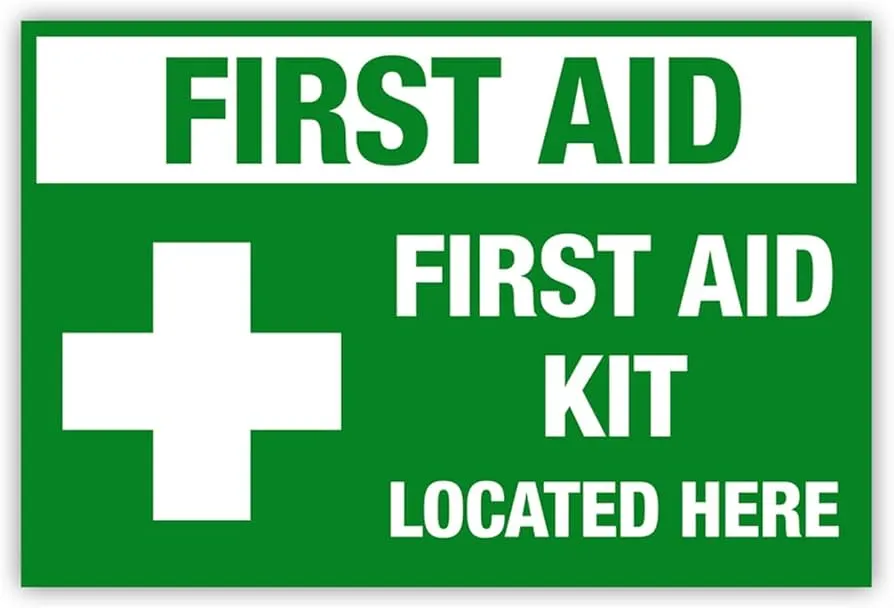In important situations, receiving clear directions can decide if someone survives or not. Having First Aid Signage makes it easy for everyone to spot where medical help is available. Having OSHA-compliant vinyl signs and First Aid Digital Signage reduces the time for response, encourages safety and helps companies ensure they meet the law. We will discuss why good signage is important and how to put it into use here.
Why First Aid Signage Matters Today

Importance in Modern Workspaces
Emergencies may happen without notice in busy offices, warehouses or co-working spaces. First Aid Signage points people to the nearest medical kits, eye-wash stations or emergency contacts. Having visible signs helps people stay calm and reflects the company’s support for health, which improves morale and trust.
Legal Requirements for First Aid Signage
OSHA, ANSI and HSE require that First Aid displays meet specific guidelines. The symbol on signs should follow ISO 7010 or ANSI Z535 rules, be a white cross on green and be clear from a distance. Ensuring these standards are met is not only to prevent fines; it helps guarantee that under pressure, all can find support.
Key Elements of Effective First Aid Signage
Good signage is simple, stands out and uses the same style throughout. Place universal icons (white cross, AED icon), directional arrows and little text where needed. They sign at eye level so they are easy to see as you look along the route. Using labels or symbols that are recognized by all helps everyone act fast in case of a crisis, regardless of their language.
Designing and Complying with First Aid Signage
Role of Color, Icons, and Typography
The use of green shows you where to go for help or safety, and red marks important warnings. Icons make understanding a complex message fast, such as a stethoscope for a doctor or a cross for religion. For visibility in dim conditions or at a distance, typography should be bold, sans-serif and high-contrast.
Best Practices in First Aid Signage Design
1. Visibility: Put signs in areas where there is a lot of activity and along places where people can see them clearly.
2. Simplicity: Use the fewest words: “First Aid Kit” or “AED →” to help people understand quickly.
3. Durability: Use materials that cannot be tampered with and are able to withstand different weather conditions in factories or outside areas.
4. Consistency: Be sure all signs have the same colors and symbols.
5. Maintenance: First Aid Digital Signage requires regular updates; printed signs should be checked every three months for any damage or signs of wear.
Compliance and Safety Standards
ISO 7010, ANSI Z535 and local fire codes guide how to create effective signage. Digital boards provide options like displays with strong contrast and the ability to read instructions aloud for those with vision problems. Check that all signs comply with local rules since EU directives might not be the same as U.S. OSHA rules, and update the records when standards are updated.
Digital vs. Traditional First Aid Signage
For small offices or businesses trying to save money, traditional signage that does not change is a good option. Even so, First Aid Digital Signage is useful since it gives updates in real-time, includes animated CPR instructions and can switch languages easily. Joining digital boards with fire alarms or sensors allows for the automatic display of emergency instructions on the board. For big areas such as campuses, hospitals or airports, the advantages of being able to use digital screens in many ways are greater than the extra cost.
Applications for First Aid Displays in Various Environments

Corporate Offices
You can place discreet digital kiosks in your office near the lobby or breakroom to show safety tips like basic CPR and where to find AED devices without interfering with the office’s design. First aid kits are easily accessible due to the static First Aid displays above the supply closets. If QR codes are placed on digital screens and linked to company emergency procedures, it provides more support.
Industrial Workplaces
Areas such as construction sites, manufacturing plants and chemical facilities need tough First Aid Signs since they are exposed to dust, water and impact. With Animated Digital Signage, untrained workers can learn what actions to take, such as how to handle chemical splashes, until the professionals arrive.
Educational Institutions
Many different people are part of the student bodies in schools and universities. First Aid Digital Signage in hallways can run emergency drills, teach CPR and update directions in case of a fire or lockdown. Signs in the nurse’s office and gymnasium help students find medical supplies fast.
Retail & Hospitality
Signs in malls, hotels and restaurants should be both useful and attractive. Multilingual first aid instructions, where AEDs are found, and the nearest hospitals can be shown on screens placed in public areas. First Aid displays in staff areas make sure employees can locate the supplies without disturbing guests.
Choosing and Customizing Your First Aid Signage
Choosing the Right First Aid Signage Company
Providers do not all have the same level of expertise. A recommended First Aid Signage Company will:
• Provide services designed for emergency communication.
• Design your website to express your brand’s identity.
• Follow OSHA, ANSI and ISO 7010 regulations.
• Give users strong support and information after their apps are installed.
Look through the company’s projects in your industry, such as healthcare, education or heavy manufacturing, and obtain testimonials about their digital content management skills.
How to Customize First Aid Signage for Your Facility
Apart from adding logos, think about how the facility is arranged, how people move around and what typical dangers are present. In places where lighting is low, pick signs that use backlit digital displays or photoluminescent paint. When working with teams who speak different languages, display First Aid content in whichever language is chosen by the users. Include company-made safety videos, maps for evacuations or links to first aid training inside the platform.
Benefits of Using Digital Signage for First Aid Communication
• Notify Staff Instantly: Send out alerts right away in case of drills or real emergencies.
• Get Interactive Tutorials: Watch how to do CPR, handle wounds and use an AED.
• Analytics & Insights: Use engagement numbers on screens to better position your signs.
• Multilingual Support: You can change the language to match the needs of your team members.
• Integration: Work together with building management systems in case of emergencies.
Elevate Your Safety with Customized First Aid Signage

Interested in changing how your organization handles emergencies? Work with a First Aid Signage Company that can create, put up and manage signs that match your requirements. Having sturdy industrial displays, attractive office signs or digital signs for first aid today could prevent accidents in the future. You can ask us to carry out a safety audit and find out which solutions will work best for your facility.
FAQs about First Aid Signage
Q1: What is the difference between digital and traditional first aid signage?
Vinyl, plastic or metal are common materials for traditional signage, which is cost-efficient in small, steady locations. Alternatively, First Aid Digital Signage is flexible, so it can be updated instantly (for instance, showing evacuation routes during a fire), include animated demonstrations (of CPR) and offer interactive options (for switching languages).
Q2: Which industries benefit most from first aid digital signage?
Since manufacturing, healthcare and education sectors need quick and flexible communication, Digital Signage for First Aid is most useful to them. Retail stores and airports also rely on having multilingual, customizable content.
Q3: How do I find the best first aid signage company?
Try to find a vendor that:
• Offers design and compliance services for First Aid Signage (ANSI, ISO 7010, OSHA).
• Can create solutions that work for static and digital displays.
• Gives regular training on how to maintain and control website content.
• It has testimonials that are positive from industries that are like yours.
Q4: What should be included in effective first aid signage design?
The main features are:
• The colors used are very different (green for safety, red for emergencies).
• Common symbols for medical help (the white cross and the AED symbol).
• Fonts that are clear and easy to see.
• Short and to-the-point text (e.g., “First Aid Kit →”).
• Voluntary inclusion of text or QR codes in other languages that lead to detailed protocols.
Q5: Can digital signage be used for first aid training?
Yes. First Aid digital signage makes it possible to display CPR, wound care and AED guides directly where employees are, helping them remember steps through visuals.
Q6: Are there compliance standards for first aid displays?
Absolutely. All signs need to comply with ANSI Z535, ISO 7010 and OSHA/HSE regulations. Making digital boards accessible for visually impaired users by adding text-to-speech, high-contrast modes and large-font text is important.
Q7: What are future innovations in first aid digital signage?
Some new trends are:
• AI Alerts: When a sensor detects an incident (such as a fall), it sends instructions to help on the screen.
• Employee Vital Monitoring: Link digital screens to employees’ wearables to get instant updates and warnings.
• Augmented Reality (AR): Involves displaying instructions for procedures, like CPR, in front of users on their phones or AR glasses.





